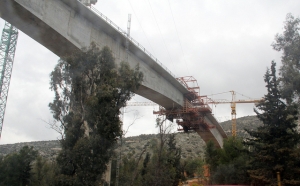
For decades, toll roads have generated revenue for critical transportation projects. Now, however, toll roads have become controversial with a segment of the population, and some elected officials are vowing to ensure that new toll roads are not created. That, of course, begs the question of where revenue can be found for critical projects.
A number of states are experimenting with new toll revenue models. Rhode Island, where 23 percent of the state’s bridges are classified as structurally deficient, implemented a truck-only toll on bridges. The state’s Department of Transportation justified the fee by explaining that 70 percent of damage to the state’s roads results from tractor-trailers. Although most states enforce higher toll charges on truckers, Rhode Island will be the first state to have a toll only for trucks.

Photo by Tilemahos Efthimiadis licensed under CC BY 2.0.
Each truck toll will be about $3, making the maximum expense for a one-way trip using Interstate 95 from Connecticut to Massachusetts $20. Transportation officials estimate that, with the new truck tolls in place, the state will receive $45 million a year and the revenue will be used for transportation projects and roadway repair.
On the other side of the spectrum, the governor of Kentucky announced that he wants to ensure no funding for a new Ohio River Bridge project is raised from tolls. However, the project to restore a functionally obsolete bridge is already underway, and it is a $2.6 billion project. There has been no alternative funding suggested and there is a question about how the project can be finished.
While toll roads have become controversial, many local leaders are being innovative in other ways.
One new roadway fee is called congestion pricing, or value pricing. The model calls for flexible costs that become elevated when traffic is at its peak.
The rationale is that congestion pricing is justified because trips have different values at different times for different individuals. During periods of high demand, drivers have the option of paying premium charges for quicker mobility or travelling in general purpose lanes without paying a toll.
In the Dallas-Fort Worth area, TEXpress Lanes use this pricing with toll rates that adjust based on supply and demand.
TEXpress Lanes have been built within existing highways, and the lanes allow the roadways to accommodate more traffic and increase overall capacity. Six major DFW corridors currently have TEXpress lanes open or in development.
Similar to express lanes, high-occupancy toll (HOT) lanes convert existing high-occupancy vehicle (HOV) lanes into priced lanes. Drivers who may not meet the occupancy requirement for an HOV lane can buy into the HOT lane by paying a toll. Besides providing a time-saving alternative for drivers, HOT lanes also improve the use of underutilized HOV lanes.
The state of Washington initiated a four-year pilot project to convert existing HOV lanes on SR 167 to HOT lanes without expanding the existing freeway. A recent report revealed that the average number of tolled trips continues to increase each year. HOT lane volumes have increased 15 percent while daily general purpose lane volumes have decreased 4 to 5 percent.
As new types of roadway projects continue to surge, another funding option is public-private partnerships (P3s). Private-sector capital is available for infrastructure projects when revenue models for repayment can be developed. While those who dislike toll roads may also dislike P3s, roadway revenue must be found somewhere. Public coffers no longer can provide it.
One inarguable fact is that the best minds from both the public and private sectors will be required if transportation infrastructure is to be maintained, repaired and expanded. Collaboration will be a critical component in the future as demands escalate.
